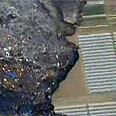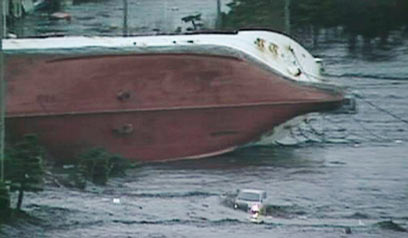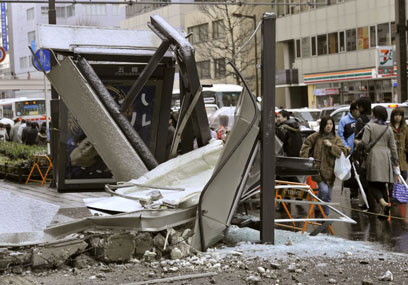
Huge tsunami slams Japan after 8.9 quake
(Video) Trains stopped, airport closes as 10-meter tsunami hits northeastern coast following massive earthquake, leaving at least 300 dead with death toll expected to climb. Waves also hit Hawaii, expected to reach US
VIDEO -
A powerful 10-meter tsunami spawned by the largest earthquake in Japan's history slammed the eastern coast Friday, sweeping away boats, cars, homes and people as widespread fires burned out of control.
Japanese police say 200 to 300 bodies have been found in a northeastern coastal area. Earlier police said at least 90 people were killed and 349 were missing. The death toll was likely to continue climbing given the scale of the disaster.
The waves also hit Hawaii in the early morning hours Friday and were sweeping through the island chain. The Pacific Tsunami Warning Center said Kauai was the first island hit early Friday by the tsunami.
Water rushed ashore in Honolulu, swamping the beach in Waikiki and surging over the break wall in the world-famous resort but stopping short of the area's high-rise hotels.
Waves at least a meter high were recorded on Oahu and Kauai, and officials warned that the waves would continue and could become larger. They are predicted to hit the western coast of the United States between 11 am and 11:30 am EST.
In various locations along Japan's coast, TV footage showed massive damage from the tsunami, with dozens of cars, boats and even buildings being carried along by waters. A large ship swept away by the tsunami rammed directly into a breakwater in Kesennuma city in Miyagi prefecture, according to footage on public broadcaster NHK.
The Kyodo news agency reported that a ship carrying 100 people was swept away by the tsunami.

Ship capsized by tsunami (Photo: Reuters)
'Enormous damage'
The magnitude 8.9 offshore quake was followed by at least 19 aftershocks, most of them of more than magnitude 6.0. Dozens of cities and villages along the 2,100-kilometer stretch of the country's eastern shore were shaken by violent tremors that reached as far away as Tokyo, hundreds of kilometers from the epicenter in the sea off the northeastern coast.
A tsunami warning was issued for the entire Pacific, including areas as far away as South America, the entire US West Coast, Canada and Alaska.
"The earthquake has caused major damage in broad areas in northern Japan," Prime Minister Naoto Kan said at a news conference.
Even for a country used to earthquakes, this one was of horrific proportions.
Large fishing boats and other sea vessels rode high waves into the cities, slamming against overpasses. Upturned and partially submerged vehicles were seen bobbing in the water.
Waves of muddy waters swept over farmland near the city of Sendai, carrying buildings, some on fire, inland as cars attempted to drive away. Sendai airport, north of Tokyo, was inundated with cars, trucks, buses and thick mud deposited over its runways. Fires spread through a section of the city, public broadcaster NHK reported.
The tsunami roared over embankments, washing cars, houses and farm equipment inland before reversing directions and carrying them out to sea. Flames shot from some of the houses, probably because of burst gas pipes.
"Our initial assessment indicates that there has already been enormous damage," Chief government spokesman Yukio Edano said. "We will make maximum relief effort based on that assessment."
He said the Defense Ministry was sending troops to the quake-hit region. A utility aircraft and several helicopters were on the way.
Biggest earthquake on record
A large fire erupted at the Cosmo oil refinery in Ichihara city in Chiba prefecture near Tokyo and was burning out of control with 30 meter-high flames whipping into the sky.
NHK showed footage of a large ship being swept away and ramming directly into a breakwater in Kesennuma city in Miyagi prefecture.

'I've never felt anything like this' (Photo: AP, Kyodo News)
The US Geological Survey said the 2:46 pm quake was a magnitude 8.9, the biggest earthquake to hit Japan since officials began keeping records in the late 1800s, according to NHK.
A tsunami warning was extended to a number of Pacific, Southeast Asian and Latin American nations, including Japan, Russia, Indonesia, New Zealand and Chile. In the Philippines, authorities said they expect a 3-foot (1-meter) high tsunami.
The quake struck at a depth of six miles (10 kilometers), about 80 miles (125 kilometers) off the eastern coast, the agency said. The area is 240 miles (380 kilometers) northeast of Tokyo.
In downtown Tokyo, large buildings shook violently and workers poured into the street for safety. TV footage showed a large building on fire and bellowing smoke in the Odaiba district of Tokyo. The tremor bent the upper tip of the iconic Tokyo Tower, a 333-meter steel structure inspired by the Eiffel Tower in Paris.
Several nuclear plants along the coast were partially shut down, but there were no reports of any radioactive leakage.
In central Tokyo, trains were stopped and passengers walked along the tracks to platforms. NHK said more than 4 million buildings were without power in Tokyo and its suburbs.
A large numbers of people waited at Tokyo's Shinjuku station, the world's busiest train station, for service to resume so they could go home. TV announcers urged workers not to leave their offices to prevent injuries in case of more strong aftershocks.
'Never felt anything like this'
Osamu Akiya, 46, was working in Tokyo at his office in a trading company when the quake hit.
It sent bookshelves and computers crashing to the floor, and cracks appeared in the walls.
"I've been through many earthquakes, but I've never felt anything like this," he said. "I don't know if we'll be able to get home tonight."
Footage on NHK from their Sendai office showed employees stumbling around and books and papers crashing from desks. It also showed a glass shelter at a bus stop in Tokyo completely smashed by the quake and a weeping woman nearby being comforted by another woman.
Several quakes had hit the same region in recent days, including a 7.3 magnitude one on Wednesday.
Thirty minutes after the main quake, tall buildings were still swaying in Tokyo and mobile phone networks were not working. Japan's Coast Guard set up a task force and officials were standing by for emergency contingencies, Coast Guard official Yosuke Oi said.
"I'm afraid we'll soon find out about damages, since the quake was so strong," he said.
Tokyo's main airport was closed. A large section of the ceiling at the 1-year-old airport at Ibaraki, about 80 kilometers northeast of Tokyo, fell to the floor with a powerful crash.
Dozens of fires were reported in northern prefectures of Fukushima, Sendai, Iwate and Ibaraki. Collapsed homes and landslides were also reported in Miyagi.
Japan's worst previous quake was in 1923 in Kanto, an 8.3-magnitude temblor that killed 143,000 people, according to USGS. A 7.2-magnitude quake in Kobe city in 1996 killed 6,400 people.
Japan lies on the "Ring of Fire" - an arc of earthquake and volcanic zones stretching around the Pacific where about 90 percent of the world's quakes occur, including the one that triggered the Dec. 26, 2004, Indian Ocean tsunami that killed an estimated 230,000 people in 12 nations. A magnitude-8.8 temblor that shook central Chile last February also generated a tsunami and killed 524 people.
Laurence Katz, a 29 year-old Israeli who has been living in Japan for five years said she has never experienced anything like this. "Things were falling on the floor; the four story building in Tokyo has been shaking for four hours. There are after shocks and occasionally, a warning siren telling people to leave their homes is heard," she told Ynet.
Laurence's husband called her right in the middle of the earthquake: "I didn’t know what to hold on to or if I should go outside. It was 3 pm; I was just organizing our new house when the quake started. It was like slow motion, my husband called to calm me down."
She noted that Japanese citizens are well trained in earthquake evacuation. "We didn't leave in hysterics because to begin with, it felt like any other quake we have here but when people realized this was stronger than usual, they started going outside faster."
Japanese consul in Israel Mitoshiko Shinomya told Ynet that the Israeli government has offered its assistance. "Israel officially offered its help an hour after the earthquake struck. It is very heart-warming, but at this point we do not know exactly what the extent of the damage is, so it is difficult for us to say what can be done.
"The airport in Tokyo is still closed, so it is too soon to speak of assistance from abroad," he said.
AP, Reuters, Ronen Medzini contributed to the report
- Follow Ynetnews on Facebook










